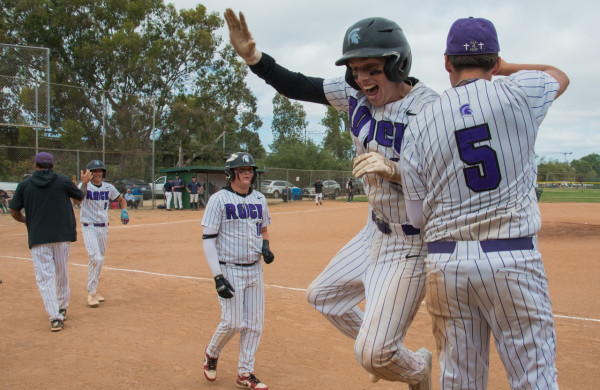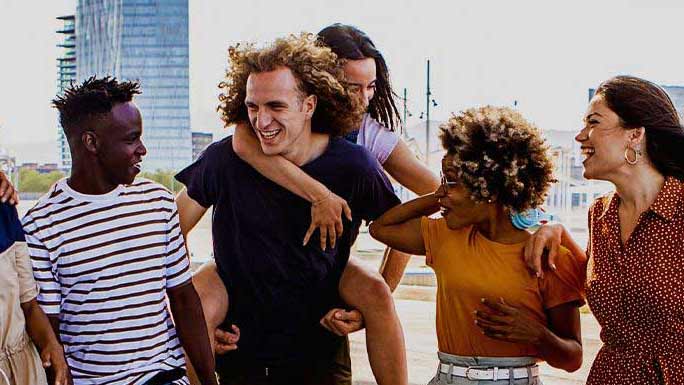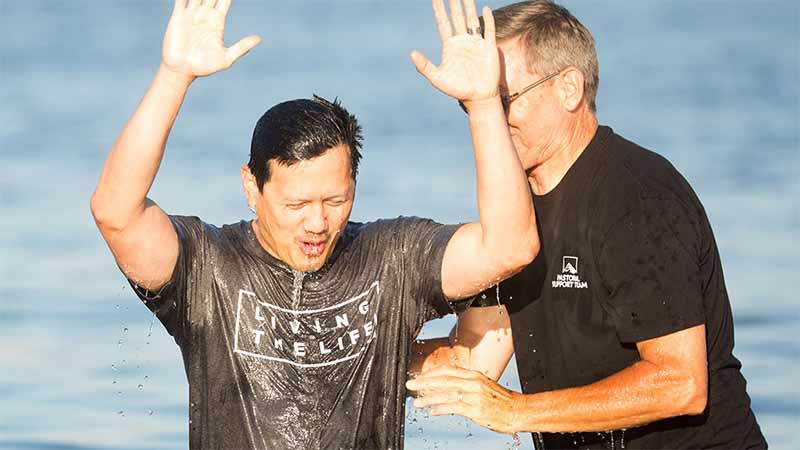The following story is the account of New York Police officer, John Heine, now the Director of Security at the Rock Church, as he arrived on scene one hour after the second World Trade Center building had collapsed in lower Manhattan, and of the days that followed the horrific event.
9 | 11
The world financial district of lower Manhattan is as alien as a lunar landscape.
Heavy white acrid smoke billows everywhere, but from what fires? There is an overpowering stink of jet fuel and antifreeze, plus coolant from the collapsed buildings' cooling towers. There is a fresh thick snowfall of about 4-6 inches of powder, beige and gray tones of ash. Every footstep sinks deep and kicks up a cloud of dust and debris. The dust is loaded with small debris like microfilm strips of paper and small bits of brick mortar and glass. It does something weird to the sound; there is no noise as I walk. People, cops, fireman, and EMT’s just seem to wade along, ghostly, gliding silently—almost dreamlike. Then again, the whole thing is like a dream.
There is an overpowering stink of jet fuel and antifreeze, plus coolant from the collapsed buildings' cooling towers.
Voices do not carry. Portable radios are squawking, but muffled. People are nearby and yelling out, but seem very far away. There are no sounds of traffic—no horns, no New York City clamour. It is very hushed. It’s like the quiet after a fresh snowfall. The activity is constant at first glance and confusing. There is great disorder. If you choose to be overwhelmed by it, then it will be overwhelming. It is utter chaos.
There is no way to manage this mess. There won’t be a comprehensive Command and Control system here for days; there is no way to get a handle on this. It’s time to get dirty. We need generators, power saws and heavy tools. Soon, we will need body bags.
Working radios are a premium. Many citywide channels are lost; the remaining working ones are jammed. Surviving commanders rally the troops and are organizing with whoever is available. There is work to be done. Units are divided up. Search quadrants are assigned. Search and dig wherever you can penetrate.
There is no way to get an overview of anything this massive. You just have to adopt the worker ant function and pitch in where needed until the mission changes. There are masses of mess everywhere. Hundreds of tons, no thousands of tons, no, millions of tons of twisted, smoldering, dust-covered unrecognizable horror.
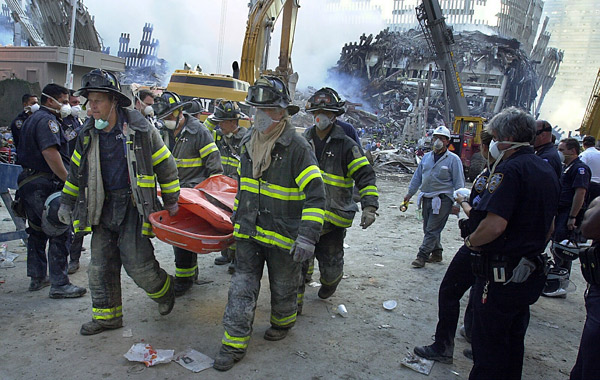
It is confusing to get a lay of the land because there is no way to reconcile this with reality. There are no more landmarks, just piles.
Before me is a smashed fire truck. All the windows are blown out, semi-buried, with all compartments emptied. There's a crushed ambulance over there. Dozens of emergency vehicles are destroyed, partially buried.
We need generators, power saws and heavy tools. Soon we will need body bags.
Where in the world did the Towers land when they collapsed? Some steel framework at the bases remain. I know where they were, but…where are they now? I try to do some figuring: the debris pile represents 110 stories of building. That's 12 feet per floor landing in a pile ten, twelve, twenty stories high? Not even close. There is maybe a three-story pile here, but it is spread over 16 acres. It is a huge, massive, uncomprehensible sight. Huge walls of smoke and dust are everywhere.
NYC Firefighters carry a piece of gear called a PASS alarm. This is designed to chirp a loud, audible alarm when it detects that the firefighter has not moved for over 30 seconds. It helps locate a firefighter in need of help who may have fallen or lost consciousness.
From the massive overwhelming pile of smoking debris, thousands of chirps could be heard from deep within. It was impossible to know where to look first.
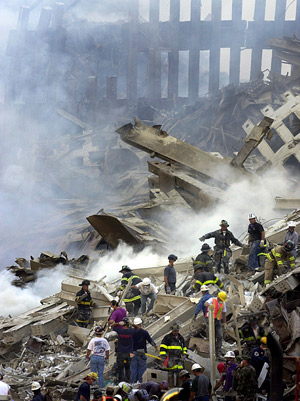
We come upon partially buried vehicles. We walk over mounds that are completely buried cars, taxis, vans. There are huge fire trucks with the cabs blown out. Not one piece of glass remains.
I notice as I walk along a building, I am not at street level. I am almost up to the second floor. It is disorienting. The first fatal casualties are bagged and left in place on the ground. There are not a lot of bags. Silent, surreal, they lay out of the way waiting for a mortuary detail to move them out.
There are solids in the drifting dust. Every now and then, you get a big chunk of ash in your eye. Everyone is covered in dust. It seems to be the uniform of the day, dust and gray. It's hard to tell cops from firemen or EMS folks from civilians. Everyone is uniformed in the gray dust of death.
It's hard to tell cops from firemen or EMS folks from civilians. Everyone is uniformed in the gray dust of death.
Digging crews are everywhere. There are certainly people trapped and we are all working as fast as possible to find them. Air pockets? Tunnels? The subway and PATH train stations? There have to be people alive in there.
But it is not to be. We find nothing but fatalities.
"There's food over there you guys," someone says. Several 4x8 sheets of plywood lay over debris. All street level restaurants and offices have been pried open for chairs and tables to make makeshift aid stations. There are several volunteers with cardboard boxes filled with hundreds of bagels sliced in half and spread with peanut butter. Any kind of bagel you want...as long as you want a plain bagel with peanut butter. There are pallets of warm bottled water stacked nearby. I grab a peanut butter bagel. I am more hungry than I realized. I take a bite. Crunch. I take a closer look. The bagels have been here for only a short while. I take a swipe with my sleeve and wipe a thick coating of dust and grit off my bagel.
My partner grimaces.
What could the crunch be? Worst-case scenario, asbestos? Can't hurt ya if ya don't breathe it. We find out later from lab tests that the ash contained gypsum wallboard, pulverized concrete dust, paper, construction material and incinerated human beings.
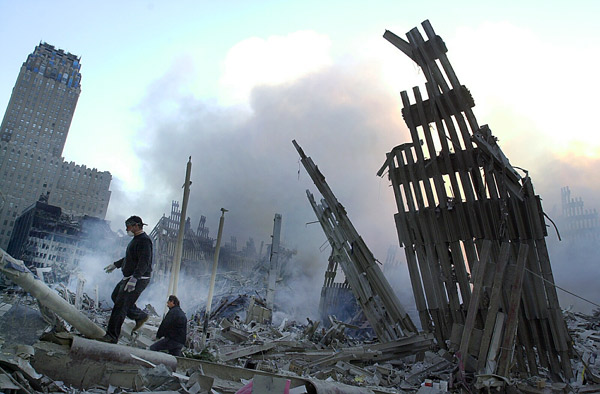
The reason the debris pile is small is because most of the upper floors pulverized everything below creating thousands of cubic yards of concrete that was reduced to dust along with 110 stories of drywall. Most of the upper floors of the World Trade Center have, in fact, drifted away as dust. The unmistakable smell of the entire area is from the tens of thousands of pounds of burned aviation fuel which fed the flames.
We find out later from lab testing that the ashes contained gypsum wallboard, pulverized concrete dust, paper, construction material and incinerated human beings.
Someone yells they need assistance, so I help form a human chain to help transport supplies. It is mindless, repetitive work; box after box of bandages, masks, water. Then come the milk crates.
What is in there?
These are clear plastic ziploc bags, or plain brown paper bags, dozens per box. They contain a single sandwich, wrapped in foil, plastic wrap, or a single size ziploc. Some have a granola bar, some have a carrot, a juice box, celery stick, and some have a cupcake.
Some bags bear a handwritten child's name. It suddenly occurs to me.
These are children's school lunches for goodness sake!
Elementary schools in Jersey City, New Jersey, had asked children to donate food for the emergency workers. They had collected school lunches and folks had gone to their cupboards and made a sandwich or cleaned out their home refrigerator and brought it down to the local firehouse or grammar school where they were stacked into the milk crates and brought to the pit.
Amazing.
Such a simple act of love for strangers. Everyone just wanted to help in any small way that they could. I was choked up and it wasn't the dust. What precious generosity these folks had shown. They saw the need and they did the best they could to help.
I think of my own kids. I am sure they are all right. I wonder if they know I am here. What of other kids everywhere? What of the kids who won't have parents coming home tonight? Shudder. I am not ready to deal with that.
"Any good news?" I ask a passing firefighter. He looked at me briefly and hung his head and shook it slowly, " No."
We weren't going to find any more people after the first day.
9 | 12
It is truly an eerie sight. Several multi-million dollar yachts are abandoned, coated in six inches of dust. Most of the glass is all blast damaged. The entire marina is covered in dust and litter: business cards, lunch menus, business reports, microfilm, blueprints and snapshots. Some were blown right out of their frames, where they once sat on someone's desk some eighty or a hundred stories up. A photo of a smiling wife and some small kids, happy. Please God, I hope this guy got home to them. Someone's smashed computer speakers are laying in the dust, a plastic vase, another photograph of smiling faces, happier times. So much happier. There are miles of videotape draped in trees and across walkways, thousands of strips of aluminum vertical blinds are everywhere downtown. The smoke is just as heavy as when we left yesterday.
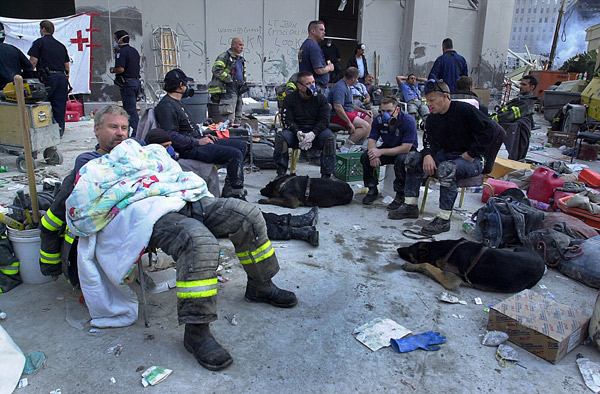
Hundreds of steel workers left construction sites all over the area to come help. A crew of American Indian high steel workers needed to get back to Brooklyn. These guys were huge, strong and bone-weary, having been there throughout the night. They left a construction site where they were working in Brooklyn and raced to the towers because they wanted to help. They said the foreman in Brooklyn told them they had to stay or risk their jobs. They claim that they told him, "See ya."
Some media reports have started calling the area, ground zero. I am a child of the sixties and know the term is from atomic bomb testing. It designates the epicenter of measurement from the detonation site of a nuclear device. Is this just as horrific as a nuclear blast or does this term trivialize the mass grave of four thousand murder victims? The missing persons total is skyrocketing, but the crime scene guys tell us there is not enough information yet to get an accurate total. Duplicate reports are altering the total count. There are at least fifty cops and as many as 400 firemen in there. The civilian total may be 3,000-4,000.
Around mid-day, cadaverous-looking firemen began to appear at the docks. They were drained and sickly-looking, shuffling up to the boats, eyes vacant, exhausted…the thousand-yard stare.
Around mid-day, cadaverous-looking firemen began to appear at the docks. They were drained and sickly-looking, shuffling up to the boats, eyes vacant, exhausted…the thousand-yard stare.
They need to go home, to rest, to mourn. But most will be back. It was apparent that they had been there since the crashes yesterday morning. It was also apparent that many of them had arrived in the many fire trucks that were destroyed. They also had spent the entire day and night searching for brothers who would not be coming home. My heart aches for these guys.
We offer them bottled water and clean towels. They just sit quietly and hang their heads, coated in the dust of death.
There are no words.
Suddenly, a rumble, some screams. Police and Fire radios squawking panic. Hundreds of firefighters, cops and medical people go charging on foot down to the docks. "Windows are blowing out of Liberty Plaza! It might come down!" There is an emergency evacuation of hundreds of people jammed into the boats. A Jersey City Fire Lieutenant is having chest pains. I have a pair of EMS medics on my boat. We transfer the medics to their boat in Mid-Hudson River. They jump on the larger boat and start working life support on him and race toward the Jersey City Docks.
He did not make it, a death footnote on a very long list of deceased.
There are three panic-driven evacuations on the second day from our side of the pit. There is just no way to be certain more buildings won't come down. My partner ends up doing many runs solo; he knows I want to be in the pit where we were still holding out hope for survivors. "Hold it!" came a voice from near the hole we were working in. Three dozen guys hold their breath. "Send in a bag," comes the call. Crap.
A bright orange bag is passed hand over hand and down into the hole where several ESU guys are digging. We all grab a breather for a few minutes, then, "Here it comes." Hand over hand, the orange body bag. I gently grab it to pass along. It weighs less than 10 pounds…a body part.
There was going to be a lot of that.
I see Bill McCormack, a Bronx Narcotics detective. "Steve Driscoll is missing," he says.
Oh Lord, no.
Steve was my friend and fellow trustee from the board of The New York Shields. Steve worked ESU Truck #4 in the Riverdale section of the Bronx. Of course Steve would be here, I thought. He would have responded from California for Pete's sake. Steve was last seen on the 20th floor, heading up. He had a working radio and was grabbing people and relaying the order to evacuate. He was sending people and firefighters out to safety because the radios were so unreliable. Nothing would have kept him out if there were people inside who needed him. That's Steve. His truck was one of the ones crushed under the debris and destroyed.
I have a familiar face to look for in the pit now. I have even more frustration when we just cannot seem to produce someone alive from the massive acres of death.
Later in his NY Times obituary, Steve's wife would say, Steve would have done this job for free, he loved it so much.
9 | 14
Light, steady rain starts around noon.
We go to the pit and get on a bucket line for the entire morning. We have a pause and I am trying to stretch. I am soaked through and clammy. It's just cool enough to make the rain really uncomfortable.
There is a girl in an oversize soggy gray sweatshirt walking down the bucket line. She has a large piece of masking tape on her shirt, which says, "SARAH" in magic marker. She carries a huge 5-gallon aluminum cooking pot with a sleeve of Styrofoam cups under her arm.
"What's in the pot?" I ask.
"Hot soup," she smiles. "Want some?"
"Absolutely." She hands me a cup of 'cream of something green'. My partner declines.
I wolf it down. It may be the best 'cream of something green' I have ever tasted. It warms me down to my wet, stinking bones. Sarah says she is a volunteer at an aid station near the perimeter. A doctor and his wife appear at the aid station, saying they live in a condo high rise just outside of the evacuation area and can see all the people working in the rain. They have made this soup from scratch in their home kitchen and brought it down. This was their last pot because they ran out of large pots. The doctor and his wife had simply cooked and donated every last bit of food they had in their home.
There are hundreds and eventually thousands of good American folks who were finding a way to do what they could to help.
I am once again choked up. There are hundreds and eventually thousands of good American folks who were finding a way to do what they could to help. The TV news and papers would be full of hundreds of these stories for months, but they could never tell all the stories about the Sarahs, the doctors, the Jersey City School children who just wanted to give. Just want to show some appreciation, do a little to help.
And they did. They helped; a thousand rescue workers were kept dry and clothed, fed and equipped from all the people who wanted to give. It is almost overwhelming and helps overshadow the horror of the most massive murder in history, replacing it with the even more massive rescue and recovery efforts in history. The support is truly heartwarming.
9 | 15
On Friday, President Bush came to visit. His presence is energizing. His words are described to us by relay over the police radio because only some of us could be near enough to see and hear him. He says, "I hear you...and the people who brought these buildings down will hear from all of us soon."
I was able to go home last night to be consumed into the arms of my three kids. It was the first time I had seen them in days and I was overcome just holding them. I experienced both incredible joy and gratitude for myself along with tremendous sorrow and loss for those that would not be able to have these reunions ever again.
My kids were concerned that I was down there every day and frightened by all the information bombarding them in the news. They wanted to know what we were doing and if I was able to rescue anybody.
I had to tell them no, but we were still looking very, very hard and we hoped that there would be good news soon.
My beautiful, innocent seven-year-old daughter, Kimmy, said, "Dad if I was scared because there was a fire or a loud noise, I would hide under my desk."
"That's a good thing to do, sweetie," I told her.
She looked at me for a moment. "Are you looking under the desks, Daddy?"
I hugged her to keep her from seeing her daddy fall to pieces.
My 10 year old, Christopher, had made a drawing of the two towers in an embrace with tears visible with an inscription that thanked all the police and firemen for helping. My son, Jonathan, also made a spectacular silhouette of the towers in front of a huge American flag and my daughter, Kimberly, had made a thank you card as well, for all the rescuers who are working so hard.
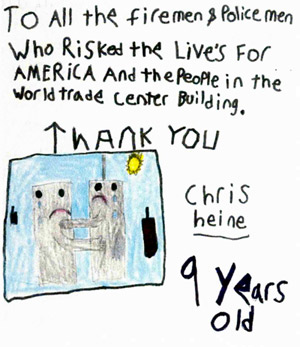
I placed these in clear plastic sleeves and promised to present them to the workers at the pit. I posted them on the entrance column to World Financial Two adjacent to ground zero. Members of various rescue teams were touched by them. Within two days, that small plaza was covered, almost every inch, by cards, posters and pictures. All forms of thank you cards came from schoolchildren and families everywhere. There were thousands of them.
9 | 16
The military is here now, huge humvees and large platoons of soldiers. They seem to march everywhere. I admire their discipline. I watch in a bone-weary state and envy their energy.
There is a short, dark-skinned Carribean guy climbing through the rubble. He is not appropriately dressed for the pit with black dress pants and black shiny shoes. He has a bullhorn and is making some form of announcement, but is hard to hear because of all the heavy equipment at work in the pit. "Catholic Mass at the fire command trailer in 10 minutes," he is saying.
Mass? I guess it is Sunday.
I take a break and head over to the fire trailer. I am met by our police commissioner.
"Good morning boss," I say. He says I look tired.
The Carribean guy removes his windbreaker and is wearing a Priest's collar. He begins to set up for Mass on a plastic folding TV tray table. About thirty of the weary form a semi circle and he begins to conduct Mass. It is tough to follow his heavy Carribean accent, but he is very solemn and sincere. The reading from his small pocket Bible was about going forth and living the Word of God, not just talking about it. He pauses and says, "This will be the shortest homily ever. I will not presume to speak to you people here, about living the Word of God. You have all shown the world how to show love for strangers. One of the people you are searching for in this devastation is my sister's husband…thank you."
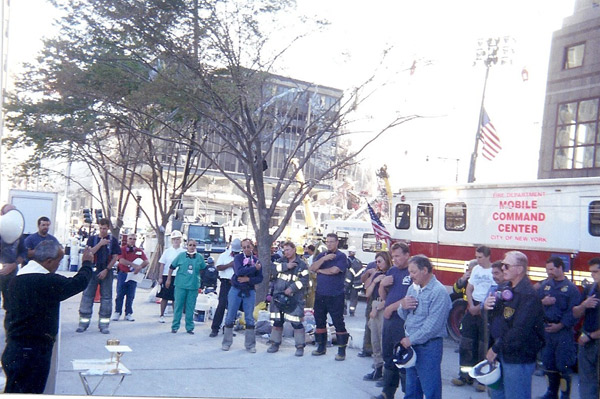
Catholic Mass, Holy Communion and gratitude rise up, spoiling the hate.
There are no words.
9 | 22
It seemed every square inch of walls, fences and light poles in the entire area surrounding the Trade Center site were now covered with thousands of posters and fliers with a picture of a loved one, father, sister, Port Authority officer, mother, office worker, firefighter, husband, wife...
All of them are printed with the silent appeal, Missing; Have you seen?; Please contact, please call; Please remember we miss you; We love you…
So much sorrow. So much loss. So much healing to do. We finish up and say our good-byes. We wish everyone well and promise to stay available. There would not be much time to switch gears. We now have to think about sixty-eight police funerals. Steve Driscoll's will be the toughest.
So much sorrow. So much loss. So much healing to do.
9 | 29
My first police funeral is ESU Officer Brian McDonnell at St. Patrick's Cathedral on Fifth Ave. I ask Christopher if he cared to come with me and pay his respects to a true hero who died trying to save strangers from an act of madness. He says yes, and we go together. I am in Class "A" full dress uniform and Chris in his best collar and tie. He stands at attention in the formation with me, marches into the magnificent cathedral and sits in hushed reverence as the closed circuit TV shows Police Officer McDonnell's two small kids in the front pew with their mom. Chris watches the kids with a steady, constant stare. Does he have a sense of how much pain they are in?
At the conclusion of the service, we reform. There are 4,000 uniformed officers standing abreast in front of the magnificent Cathedral. Hundreds of regular workday New Yorkers are trapped behind the barricades, closing Fifth Avenue entirely for the duration of the memorial service.
In the formation of four thousand are police officers from agencies spanning the entire U.S. I see patches from the California Highway Patrol, Miami-Dade, Chicago, Tucson, Boston, Albany, and so many others.
All of Fifth Avenue, in the heart of New York City, is absolutely silent as if time has stood still.
We stand in silence at attention as TAPS is played. The family stands in front of the Cathedral and the NYPD Ceremonial Unit fold the flag, silently, with great reverence.
There is no coffin.
After the flag is folded and the limousines containing the family pull away, the formation is called to attention and dismissed. We disperse and walk our separate ways.
I think to myself, One funeral down, about sixty-seven more to go.
Chris and I walk north on Fifth Avenue, past all the hundreds of silent New Yorkers stopped at the barricades. I think to myself, One funeral down, about sixty-seven more to go.
As Chris and I walk with dozens of other cops from different agencies, hundreds of New Yorkers, inconvenienced by the barricades and re-routing of traffic, break into a spontaneous standing ovation for us as we walk up the center of Fifth Avenue. First a couple, then a dozen, then hundreds of New Yorkers all applauding, graciously.
New York City, just days after 9/11, wasn't supposed to be a place of love, but like the sun's rays after a rain storm, love broke through. Hate was no match.

